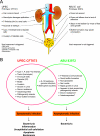Mellowing out: adaptation to commensalism by Escherichia coli asymptomatic bacteriuria strain 83972
- PMID: 17502385
- PMCID: PMC1951988
- DOI: 10.1128/IAI.01730-06
Mellowing out: adaptation to commensalism by Escherichia coli asymptomatic bacteriuria strain 83972
Figures


Similar articles
-
The Basics of Bacteriuria: Strategies of Microbes for Persistence in Urine.Front Cell Infect Microbiol. 2016 Feb 8;6:14. doi: 10.3389/fcimb.2016.00014. eCollection 2016. Front Cell Infect Microbiol. 2016. PMID: 26904513 Free PMC article. Review.
-
Comparison of asymptomatic bacteriuria Escherichia coli isolates from healthy individuals versus those from hospital patients shows that long-term bladder colonization selects for attenuated virulence phenotypes.Infect Immun. 2012 Feb;80(2):668-78. doi: 10.1128/IAI.06191-11. Epub 2011 Nov 21. Infect Immun. 2012. PMID: 22104113 Free PMC article.
-
Virulence potential of Escherichia coli strains causing asymptomatic bacteriuria during pregnancy.J Clin Microbiol. 2011 Nov;49(11):3950-3. doi: 10.1128/JCM.00892-11. Epub 2011 Sep 14. J Clin Microbiol. 2011. PMID: 21918033 Free PMC article.
-
Molecular characterization of the Escherichia coli asymptomatic bacteriuria strain 83972: the taming of a pathogen.Infect Immun. 2006 Jan;74(1):781-5. doi: 10.1128/IAI.74.1.781-785.2006. Infect Immun. 2006. PMID: 16369040 Free PMC article.
-
Blueprinting the regulatory response of Escherichia coli to the urinary tract.Trends Microbiol. 2005 Jun;13(6):246-8. doi: 10.1016/j.tim.2005.03.014. Trends Microbiol. 2005. PMID: 15936653 Review.
Cited by
-
Contribution of siderophore systems to growth and urinary tract colonization of asymptomatic bacteriuria Escherichia coli.Infect Immun. 2012 Jan;80(1):333-44. doi: 10.1128/IAI.05594-11. Epub 2011 Sep 19. Infect Immun. 2012. PMID: 21930757 Free PMC article.
-
The Basics of Bacteriuria: Strategies of Microbes for Persistence in Urine.Front Cell Infect Microbiol. 2016 Feb 8;6:14. doi: 10.3389/fcimb.2016.00014. eCollection 2016. Front Cell Infect Microbiol. 2016. PMID: 26904513 Free PMC article. Review.
-
Variation in endogenous oxidative stress in Escherichia coli natural isolates during growth in urine.BMC Microbiol. 2012 Jun 22;12:120. doi: 10.1186/1471-2180-12-120. BMC Microbiol. 2012. PMID: 22727065 Free PMC article.
-
Molecular analysis of asymptomatic bacteriuria Escherichia coli strain VR50 reveals adaptation to the urinary tract by gene acquisition.Infect Immun. 2015 May;83(5):1749-64. doi: 10.1128/IAI.02810-14. Epub 2015 Feb 9. Infect Immun. 2015. PMID: 25667270 Free PMC article.
-
What is a pathogen? Toward a process view of host-parasite interactions.Virulence. 2014;5(8):775-85. doi: 10.4161/21505594.2014.960726. Virulence. 2014. PMID: 25483864 Free PMC article. Review.
References
-
- Anderson, G. G., J. J. Palermo, J. D. Schilling, R. Roth, J. Heuser, and S. J. Hultgren. 2003. Intracellular bacterial biofilm-like pods in urinary tract infections. Science 301:105-107. - PubMed
-
- Bäckhed, F., B. Alsen, N. Roche, J. Angstrom, A. von Euler, M. E. Breimer, B. Westerlund-Wikstrom, S. Teneberg, and A. Richter-Dahlfors. 2002. Identification of target tissue glycosphingolipid receptors for uropathogenic, F1C-fimbriated Escherichia coli and its role in mucosal inflammation. J. Biol. Chem. 277:18198-18205. - PubMed
-
- Bergsten, G., M. Samuelsson, B. Wullt, I. Leijonhufvud, H. Fischer, and C. Svanborg. 2004. PapG-dependent adherence breaks mucosal inertia and triggers the innate host response. J. Infect. Dis. 189:1734-1742. - PubMed
Publication types
MeSH terms
Substances
LinkOut - more resources
Full Text Sources

